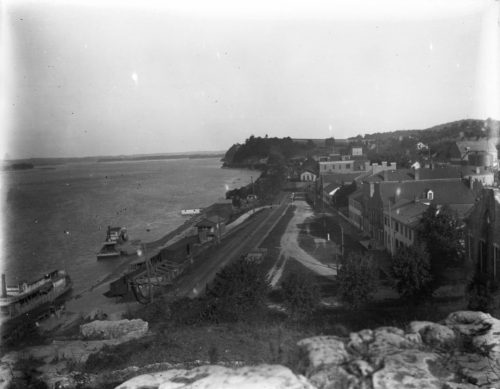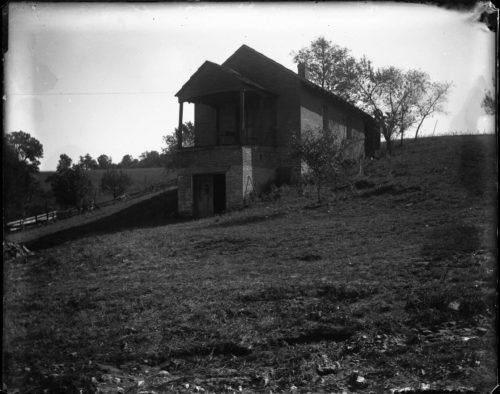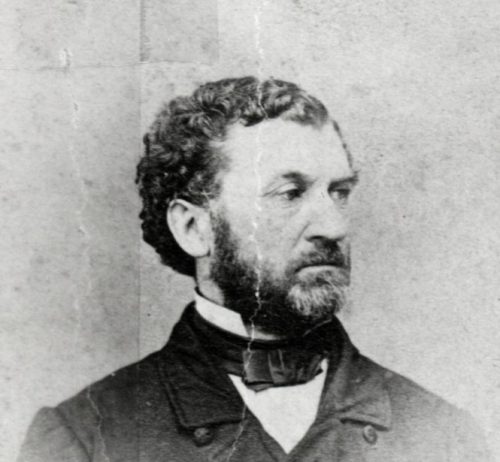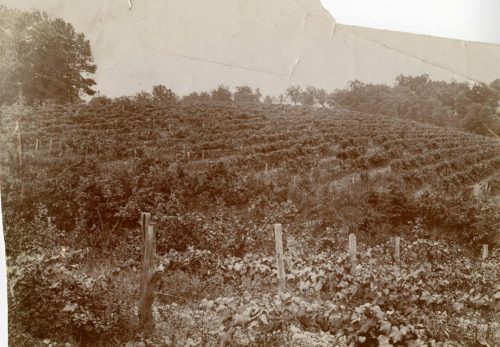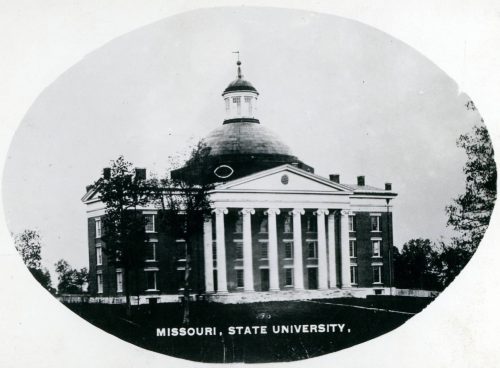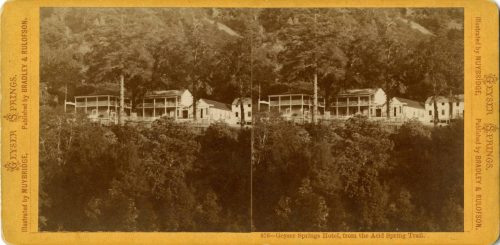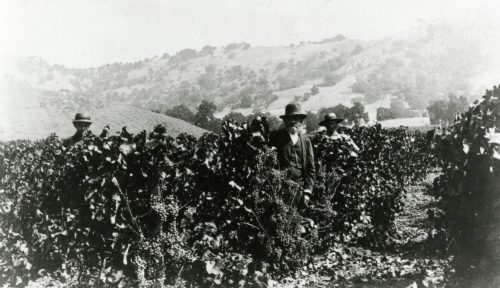![Husmann Profile George Husmann, date unknown. [Gasconade County, Missouri, Photograph Collection (P1128), SHSMO]](https://historicmissourians.shsmo.org/wp-content/uploads/2025/07/Husmann-Profile-275x375.jpg)
George Husmann
Introduction
Considered to be the “father of commercial grape growing in Missouri,” George Husmann was a German immigrant who played an important part in the rise of winemaking in Missouri and California. He is also recognized for helping to save the wine industry in France from an insect that was killing the grapes used to make French wines.
Early Years
George Husmann was born on November 4, 1827, in Meyenburg, a town in what is now eastern Germany, to J. H. Martin and Louise Charlotte Wesselhoeft Husmann. His father worked as a teacher, justice of the peace, and gardener. George attended school in Meyenburg, and his older brother Frederick later tutored him at home. In 1837 the Husmanns immigrated to the United States. Living at first in Philadelphia, the family became interested in an organization called the German Settlement Society, which soon went to Missouri and established a German-speaking community. After paying a fee to join the group, the Husmanns left Philadelphia in the winter of 1838–1839 and traveled overland to Hermann, Missouri.
Life in Hermann
Beginning as a small outpost on the banks of the Missouri River, Hermann soon became a flourishing community. The town’s success depended on agriculture and river commerce. Records suggest that the first grape vineyards in Hermann were planted around 1845. George Husmann soon planted a vineyard on his family’s farm. Unfortunately, George’s teenage years were marked by tragedy, as both of his parents passed away. By the end of the 1840s, Husmann grew restless and joined the California Gold Rush after gold was discovered there in 1848. In 1852, after the death of his brother-in-law, Charles Teubner, whom George had worked for as an apprentice, he returned to Hermann to help his sister Josephine with the family farm.
In the years immediately before the Civil War, Husmann became known as an expert viticulturist, one who studies and cultivates grapes. He was an early advocate for the Norton, a grape from Virginia that had slowly made its way into Missouri by the 1830s and 1840s. Though it would eventually become the Missouri state grape, the Norton was criticized at first by winemakers for its dry flavor. But within a few years, Husmann’s critics began to request cuttings and graftings of Norton grapes from him. He also began growing Concord grapes, known more for their use in jelly than in wine, into his vineyards. He helped found the Missouri Fruit Growers’ Association, which was later called the Missouri Horticultural Society.
State Constitutional Convention
When the Civil War began in 1861, Husmann volunteered for the Union army and served with the Fourth Missouri Infantry Volunteers. He lived to see the end of the war, but his business partner, Charles Manwaring, was killed by Confederate bushwhackers. In 1865, Husmann was selected to be part of a state convention to write a new constitution for Missouri. While at the constitutional convention, Husmann signed a law to end slavery in Missouri. Yet he voted against the new state constitution, arguing that it did not go far enough to ensure rights and opportunities for formerly enslaved people.
Grape Phylloxera
At the end of the 1860s, Husmann established a winery in Hermann and was a charter member of the Missouri State Board of Agriculture. He also published the journal Grape Culturist, produced the influential book Cultivation of the Native Grape and Manufacture of American Wines, and managed the Bluffton Wine Company in Montgomery County.
Husmann became a key contributor to the international effort to address the issue of grape phylloxera, a tiny insect native to North America that eats the roots and leaves of grape vines. In the 1860s, increased shipments of grape vines between Europe and the United States may have led to the outbreak of grape phylloxera in France. Unable to see the tiny insects, many vineyard owners and workers did not know what was causing grapes to die all across France. By the 1870s, as many as 40 percent of French vineyards had been destroyed by grape phylloxera.
Scientists, farmers, and winemakers in Europe and the United States began working together to find a solution. In Missouri, Charles Valentine Riley, then serving as the state entomologist (the government’s lead scientist on insects), read reports of grape phylloxera in France and worked with local experts such Husmann and Herman Jaeger of Newton County, Missouri, to investigate the matter. Soon, Riley, Husmann, and Jaeger discovered that while grape phylloxera in France attacked the plant’s roots, the same insects in the United States tended to attack the plant’s leaves. When their findings were confirmed by French officials, a massive effort began to import American vines as well as to grow French vines by placing them onto American plant roots, a practice called grafting. While there is still no way to fully prevent grape phylloxera, by the end of the nineteenth century, new and grafted vines had rescued French vineyards.
University of Missouri
In 1870, Husmann was appointed to the University of Missouri Board of Curators. Due to an economic depression in the early 1870s, Husmann’s winery in Hermann closed and he moved to Sedalia to start a business focused on growing fruit, vegetables, and flowers for sale. When that business failed, Husmann was hired as a professor and superintendent of forestry and pomology, the study of fruit cultivation, at the University of Missouri. While teaching there, he founded the Mississippi Valley Horticultural Society, which later became the American Horticultural Society.
Napa Valley
At the University of Missouri, Husmann became interested in the rising wine industry in California. His 1880 publication American Grape Growing and Wine Making included a section on California wines. Eager for a new challenge, especially since California’s vineyards were facing their own struggles with grape phylloxera, Husmann moved to Napa, California, in 1881 to work at the 2,200-acre Talcoa Ranch. Back in the winemaking business, he helped establish vineyards that turned Napa Valley into a major wine-producing region in the United States.
Legacy
For the rest of his life, Husmann was a respected figure in the wine industry, and he represented California at several international fairs in which his wines won high praise and awards at places such as the 1889 World’s Fair in Paris and the 1893 World’s Columbian Exposition in Chicago. His books, especially Cultivation of the Native Grape and Manufacture of American Wines, remained important to winemakers. Hussman died on November 5, 1902, and was buried in Tulocay Cemetery in Napa.
Text and research by Sean Rost
References and Resources
For more information about George Husmann’s life and career, see the following resources:
Society Resources
The following is a selected list of books, articles, and manuscripts about George Husmann in the research centers of The State Historical Society of Missouri. The Society’s call numbers follow the citations in brackets.
Articles from the Newspaper Collection
- “Culture of the Grape.” St. Louis Globe-Democrat. September 11, 1868. p. 4.
- “Missouri Fruit Growers’ Association.” Daily Missouri Republican. October 4, 1859. p. 3.
- “Pomona’s Patrons.” St. Louis Globe-Democrat. January 21, 1880. p. 8.
- “The Agricultural College.” Columbia Missouri Herald. December 5, 1878. p. 4.
- “Was a Teacher at M.S.U.” Kansas City Star. November 6, 1902. p. 1.
- Heming, Carol. “George Husmann (1827-1902).” Missouri Encyclopedia. Originally published in Dictionary of Missouri Biography, edited by Lawrence O. Christensen, William E. Foley, Gary R. Kremer, and Kenneth H. Winn, pp. 416-417. Columbia: University of Missouri Press, 1999. [REF 508 D561]
- Hooker, H. D. “George Husmann.” Missouri Historical Review 23, no. 3 (April 1929): 253-260. [REF F550 M691]
- Husmann, George. American Grape Growing and Wine Making. New York: Orange Judd Company, 1896. [REF 634.8 H96 1904]
- Husmann, George. An Essay on the Culture of the Grape in the Great West. Hermann: C. W. Kielmann, 1863. [REF I H96]
- Husmann, George. Descriptive Catalogue of Evergreen and Deciduous Ornamental Trees and Shrubs: and Other Green-House and Bedding Plants, and flowers, grape vines, fruit trees, etc. Sedalia: Democrat Power Press Print, 1872. [REF H242.28 H96 1872]
- Husmann, George. Some Uses of the Grapevine and Its Fruit. Washington, D.C.: U.S. Department of Agriculture, 1905. [REF I H96s]
- Husmann, George. The Cultivation of the Native Grape, and Manufacture of American Wines. New York: F. W. Woodward, 1868. [REF I H96c]
- Husmann, George. ed. The Grape Culturist. St. Louis: R. P. Studley & Co., 1869-1871. [REF F531.1 G767]
- Kliman, Todd. “The Ignoble Grape: The Rise Fall, and Rise Again of the Outsider Norton.” Missouri Historical Review 109, no. 2 (January 2015): 93-107. [REF F550 M691]
- Lukacs, Paul. American Vintage: The Rise of American Wine. Boston: Houghton Mifflin, 2000. [REF 663.2 L968]
- Muehl, Siegmar. “Winegrowing in the Hermann Area: Early Years’ Chronicle.” Missouri Historical Review 87, no. 3 (April 1993): 233-252. [REF F550 M691]
- Stevens, Linda Walker. “The Making of a Superior Immigrant: George Husmann, 1837-1854.” Missouri Historical Review 89, no. 2 (January 1995): 119-138. [REF F550 M691]
- What Wondrous Life: The World of George Husmann: A Photographic Exhibit of the Life of Achievement of George Husmann. Columbia: University of Missouri-Columbia, Western Historical Manuscript Collection, 2002. [REF F508.1 H96]
- Adolf E. and Rebecca B. Schroeder Collection (C4483)
The papers of Adolf Schroeder, professor of German at the University of Missouri-Columbia, and his wife Rebecca, editor of the Missouri Heritage Readers book series, including their work with European-American oral histories and Missouri folklore and folk music. - Edward J. Kemper Collection (C4388)
This collection documents the activities of Edward J. Kemper, particularly Hermann Grape Nurseries and his other business ventures, and his local German-American community in Hermann, Missouri, and surrounding Gasconade County in the late nineteenth and early twentieth centuries. - William Clark Breckenridge Papers (C1036)
The papers of the St. Louis businessman, writer, and historian contain correspondence, scrapbooks, book sale announcements, and miscellaneous materials, with an emphasis on St. Louis and Missouri history.
Outside Resources
These links will take you outside the Society’s website. The Society is not responsible for the content of the following websites:
- Hermann Farm
This website is hosted by Hermann Farm and features a biography of George and Louise Husmann.

